Adventist Youth Honors Answer Book/Nature/Amphibians
| Amphibians | ||
|---|---|---|
| Nature General Conference See also Amphibians - Advanced |
Skill Level 1 | 
|
| Year of Introduction: 1945 | ||
|
The Amphibians Honor is an optional component of the Naturalist Master Award . |
|
The Amphibians Honor is an optional component of the Zoology Master Award
(available only in the South Pacific Division) |
1. What are the characteristics of amphibians?
[edit | edit source]Amphibians live half of their lives in water and half on land. They are cold-blooded vertebrates. Amphibians are able to breathe through their skin, making them very sensitive to anything they come in contact with, including human hands. When observing amphibians, one should never touch them. Amphibians have toes rather than claws.
2. Name the two main orders of amphibia and tell how to distinguish between them.
[edit | edit source]- Order Anura (frogs and toads)
- Adult frogs and toads are characterized by long hind legs, a short body, webbed digits, protruding eyes and the absence of a tail. Most have a semi-aquatic lifestyle, but move easily on land by jumping or climbing. They typically lay their eggs in puddles, ponds or lakes; and their larvae, called tadpoles, have gills and develop in water.
- Order Caudata (newts and salamanders)
- Cuadata have slender bodies, short legs, and long tails. The moist skin of the amphibians fits them to habitats either near water or under some protection on moist ground, usually in a forest. Some species are aquatic throughout life, some take to the water intermittently, and some are entirely terrestrial as adults. Salamanders superficially resemble lizards, but are easily distinguished by their lack of scales. They are capable of regenerating lost limbs.
3. Distinguish between toads and frogs.
[edit | edit source]The use of the common names "frog" and "toad" has no taxonomic justification. From a taxonomic perspective, all members of the order Anura are frogs, but only members of the family Bufonidae are considered "true toads". The use of the term "frog" in common names usually refers to species that are aquatic or semi-aquatic with smooth or moist skins, and the term "toad" generally refers to species that tend to be terrestrial with dry, warty skin. An exception is the Fire-bellied toad (Bombina bombina): while its skin is slightly warty, it prefers a watery habitat.
4. How do amphibians protect themselves?
[edit | edit source]The first line of defense for amphibians is to not be seen by a potential predator. The small size and coloration of many species help in this regard, but sometimes, rather than blending in, frogs are very brightly colored. The coloration in this case serves as a warning, for these frogs are poisonous.
Many frogs contain mild toxins that make them distasteful to potential predators. For example, all toads have large poison glands—the parotid glands—located behind the eyes on the top of the head. Some frogs, such as some poison dart frogs, are especially toxic.
Salamanders have the ability to detach their tails at will. When a predator captures a salamander by the tail, the salamander detaches its tail and escapes. The tail regenerates or grows back.
5. Make a list of amphibians that should be found in your locality. Identify five and tell where you found them. OR Collect pictures or sketch five different amphibians which you can identify and tell where they are found.
[edit | edit source]
| Gymnophiona (Caecilians) | |
|---|---|
|
Where found: Caecilians are found in wet tropical regions of Southeast Asia, India and Sri Lanka, parts of East and West Africa, the Seychelles islands in the Indian Ocean and in northern and eastern South America.
Description: Caecilians completely lack limbs, making the smaller species resemble worms, while the larger species with lengths up to 1.5 meters
|
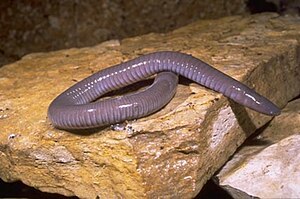 |
| Lithobates (Rana) catesbeianus (Bullfrog) | |
|---|---|
|
Where found: The American Bull Frog is native to North America. They are found in the United States, Canada and Mexico, east of the Rocky Mountains, but have been introduced to many other localities throughout the world. In Europe and the western U.S., measures are often taken to control its spread because it competes with, and often drives out, native species.
Description: The bull frog is a large species that has many similarities to its 'sister species' of toad, and can grow to a length of 6 inches (15 cm) with a weight of up to 1.5 lb (750 g). Females are typically larger than males. They are generally varying shades of green or brown, with dark brown, dark green, or black blotching and a yellow or white underside. Bull frogs are carnivorous and will consume almost anything that fits into their mouth which they can overpower, including insects, small mammals, fish, snakes, and even other frogs. They tend to eat more dragonflies than flies. The adult frog can live up to 13 years.
|
 |
| Anaxyrus (Bufo) americanus (American Toad) | |
|---|---|
|
Where found: The American toad is a common species of toad found throughout the eastern United States and Canada.
Description: The American toad is a medium sized toad usually found in the range from 2 to over 3 1/2 inches. The color and pattern is somewhat variable. The Eastern American toad has spots that contain only one to two warts. It also has enlarged warts on the tibia or lower leg below the knee. While the belly is usually spotted, it is generally more so on the forward half (in some rare individuals there may be few or no spots).
|
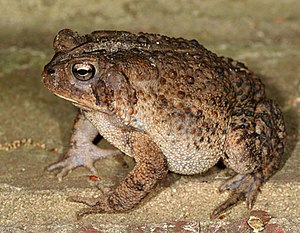 |
| Hyla versicolor (Grey Tree Frog) | |
|---|---|
|
Where found: Grey tree frogs inhabit a wide range, and can be found in most of the eastern half of the United States, as far west as central Texas. They also range into Canada in the provinces of Ontario and Manitoba, with an isolated population in New Brunswick.
Description: Grey tree frogs live primarily in trees, spending time in wooded areas, usually not far from a permanent water source. On rainy evenings they can often be found calling in or near shallow, temporary pools of water. They are nocturnal and insectivorous, consuming most any small arthropod they can catch. Mating occurs throughout the spring and summer months.
|
 |
| Hyla crucifer (Spring Peeper) | |
|---|---|
|
Where found: There are two subspecies of the spring peeper, the northern (P. c. crucifer) and the southern spring peeper (P. c. bartramiana). The northern is similar to the southern except for a strong dark marking on the southern frog's belly. The southern spring peeper is limited to northern Florida and southern Georgia, while the northern can be found all over the east of the USA and eastern Canada.
Description: The spring peeper is a small frog, attaining an adult size between 0.75 and 1.5 inches (up to 40mm) long. They have a dark cross on their backs roughly in the shape of an "X", though sometimes the marking may be indistinct. The color variations of the spring peeper are mostly tan, brown, olive green, or gray. Females are lighter-colored, while males are slightly smaller and usually have dark throats. Spring peepers are nocturnal frogs, so they are mostly heard but not seen. And they are especially easy to hear due to their extremely loud mating call which gives them the name "peeper".
|
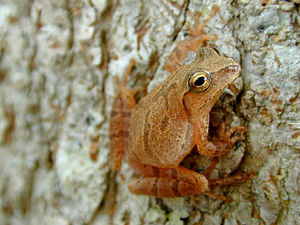 |
| Lithobates sylvaticus (Wood Frog) | |
|---|---|
|
Where found: Wood Frogs are found from northern Georgia and in isolated colonies in the central highlands in the eastern to central parts of Alabama, up through the northeastern United States, and all the way across Canada into Alaska. It is the most widely distributed frog in Alaska. They can be found from southeastern Alaska to north of the Brooks Range.
Description: Wood Frog is the common name given to Lithobates sylvaticus, previously Rana sylvatica. They are the only frogs found north of the Arctic Circle. In winter, as much as 35-45% of the frog's body may freeze, and turn to ice. Ice crystals form beneath the skin and become interspersed among the body's skeletal muscles. During the freeze the frog's breathing, blood flow, and heartbeat cease. Freezing is made possible by specialized proteins, glucose and perhaps accumulation of urea, which prevent intracellular freezing and dehydration. Wood Frogs primarily breed in ephemeral pools rather than permanent water bodies such as ponds or lakes. Adults emerge from hibernation in early spring and migrate to nearby pools. There, males chorus (a quacking sound) and mating occurs. Adult Wood Frogs spend summer months in moist woodlands, forested swamps, and bogs where they forage and maintain body moisture as surrounding environments dry out. Females' eggs are formed by late fall. By late fall or early winter, they leave forested swamps and travel to neighboring uplands to overwinter. Some may remain in moist areas to overwinter. They tend to hibernate in the upper organic layers of the soil, under leaf litter, and in close proximity to breeding pools.
|
 |
| Rana (Leopard Frog) | |
|---|---|
|
Where found: Once abundant in North America and Canada, their population has declined in recent years because of pollution and deforestation. Leopard frogs are often used as environmental indicator species because of their heightened sensitivity to chemical pollutants found in the air and water.
Description: Leopard frogs, which are also called meadow frogs and grass frogs, are a collection of so-called true frog within the genus Rana. They are commonly used as dissection specimens in biology classrooms. Leopard frogs are recognized by their green or brown coloration with distinct light-edged dark spots across the back and white underside. They also have a characteristic line of raised glandular skin extending from each eye to the groin.
|
 |
| Pseudacris regilla (Pacific Chorus Frog) | |
|---|---|
|
Where found: The Pacific Chorus Frog, formerly the Pacific Tree Frog (Hyla regilla) is a species of chorus frog native to the pacific coast of North America from Baja California in Mexico, through the states of California, Oregon, Washington (it is the Washington state frog), and into Canada and extreme southern Alaska. It ranges east into Nevada and Idaho.
Description: This is probably the most commonly heard and encountered frog in California and its call is often heard as a nighttime background sound in Hollywood movies. The Pacific tree frog can reach up to about 5 cm in length. The males are often smaller than the females. These frogs can have highly variable color on their bodies anywhere from gray, brown, tan or bright green and can even change between them. They are usually a pale or white color on their bellies. They have many variations of markings on their back and sides that are usually dark and spotty. The one identifiable mark is a dark stripe that goes over the eye from the nose to the shoulder. Their skin is covered in small bumps. They have long legs compared to their bodies and they tend to be slender. Their toes are long and are only very slightly webbed. On the end of each toe, there is a round sticky pad that is used for climbing and sticking to surfaces.
|
 |
| Litoria caerulea (Australian Green Tree Frog) | |
|---|---|
|
Where found: The Australian Green Tree Frog, simply Green Tree Frog in Australia, White's Tree Frog, or Dumpy Tree Frog (Litoria caerulea) is a species of tree frog native to Australia and New Guinea, with introduced populations in New Zealand and the United States.
Description: The Green Tree Frog can grow up to 10 centimeters (4 inches) in length. Its color depends on the temperature and color of the environment, ranging from brown to green; the ventral surface is white. The frog occasionally has small, white, irregularly shaped spots on its back, up to five millimeters in diameter, which increase in number with age.
|
 |
| Cryptobranchus alleganiensis (Eastern Hellbender) | |
|---|---|
|
Where found: The range of the Eastern Hellbender (C. a. alleganiensis) in North America extends from southwestern and south central New York, west to southern Illinois, and south to extreme northeastern Mississippi and the northern parts of Alabama and Georgia. A disjunct population occurs in east-central Missouri. The Ozark Hellbender (C. a. bishopi) subspecies exists as a disjunct population in southeastern Missouri and adjacent northwest Arkansas. Hellbenders are considered endangered in Illinois, Indiana, Maryland, and Ohio and rare or of "special concern" in Georgia, New York, North Carolina and Virginia.
Description: The Hellbender is a large aquatic salamander native to North America whose habitat includes large, swiftly flowing streams with rocky bottoms. Common names include the "snot otter" and "devil dog." Hellbenders have a flat body and head, with small eyes. Like all salamanders, they have short legs and thin bodies. Their tails, however, are especially keeled to help propel them through water. They have four toes on their front legs and five on their back ones.
|
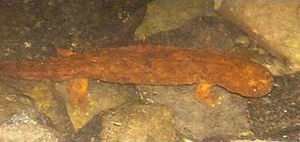 |
| Necturus maculosus (Common Mudpuppy) | |
|---|---|
|
Where found: The Common Mudpuppy is a species of aquatic salamander found throughout the northeastern United States, and parts of Canada.
Description: Mudpuppies prefer shallow water with lots of places to hide, but have been found at depths of up to 90 feet. The mating season is late autumn however eggs are not laid until late spring when 50 to 100 eggs are deposited in a nest cavity under a rock or other object. It takes 1 to 2 months for the eggs to hatch and 4 to 6 years for the young to reach maturity. Mudpuppies may live for up to 20 years. The common mudpuppy is nocturnal, but can be active in the day in muddy or weed-choked waters. It is carnivorous and feeds on fish, fish eggs, crayfish, insects, and molluscs.
|
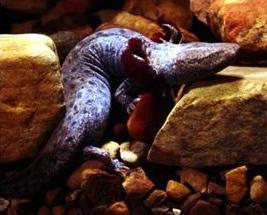 |
| Siren intermedia (Lesser Siren) | |
|---|---|
|
Where found: The Lesser Siren is found in the United States, primarily from Virginia to Florida, and west to Texas (ranging into northeastern Mexico as far as Vera Cruz), and north to Illinois, Indiana and Michigan.
Description: The Lesser Siren appears distinctly eel-like, with an elongated body, 7-26 inches (18-68 cm) in length. They have a pair of greatly reduced front legs, but no back legs. Their head is flattened and blunt with feather-like external gills on each side. They vary in color, from olive green to black, sometimes with darker colored speckling. The Lesser Siren is nocturnal, spending its days hidden in the debris and mud at the bottom of slow moving bodies of water. They feed primarily on aquatic invertebrates, including various kinds of worms, snails, and crustaceans. They will also eat the tadpoles and eggs of other amphibians.
|
 |
| Pseudobranchus striatus (Northern Dwarf Siren) | |
|---|---|
|
Where found: South-eastern United States
Description: The Northern Dwarf Sirenis a salamander lacking hind legs. It retains its gills into adulthood.
|
 |
6. Describe the life history of some amphibian.
[edit | edit source]Frogs
[edit | edit source]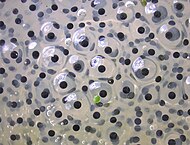



The life cycle of frogs, like that of other amphibians, consists of four main stages: egg, tadpole, metamorphosis and adult. The reliance of frogs on an aquatic environment for the egg and tadpole stages gives rise to a variety of breeding behaviours that include the well-known mating calls used by the males of most species to attract females to the bodies of water that they have chosen for breeding. Some frogs also look after their eggs—and in some cases even the tadpoles—for some time after laying.
The life cycle of a frog starts with an egg. Eggs are generally laid in water, and an individual female may lay egg masses containing thousands of eggs. While the length of the egg stage depends on the species and environmental conditions, aquatic eggs generally hatch within one week.
Some frogs do not have the tadpole stage going from egg to adult shape e.g. New Zealand's native frogs (pepeketua) belong to the genus Leiopelma. Eggs hatch and continue life as tadpoles (occasionally known as polliwogs). Tadpoles are aquatic, lack front and hind legs, and have gills for breathing and tails with fins for swimming. Tadpoles are typically herbivorous, feeding mostly on algae, including diatoms that are filtered from the water through the gills. Some species are carnivorous at the tadpole stage, eating insects, smaller tadpoles and fish. The tadpole stage may be as short as a week, or tadpoles may overwinter and metamorphosis the following year in some species, such as the Midwife toad (Alytes obstetricans) and the Common Spadefoot (Pelobates fuscus).
At the end of the tadpole stage, frogs undergo metamorphosis, in which they transition into adult form. Metamorphosis involves a dramatic transformation of body shape and function, as tadpoles develop hind legs and then front legs, lose their gills and develop lungs. Their intestines shorten as they shift from an herbivorous to a carnivorous diet. The final stage of development from froglet to adult frog involves the loss of the tail.
After metamorphosis, young adults may leave the water and disperse into terrestrial habitats, or continue to live in the aquatic habitat as adults. Almost all species of frogs are carnivores as adults, eating invertebrates such as spiders, insects, snails, and slugs. A few of the larger species may eat prey such as small mammals, fish and smaller frogs. Some frogs use their sticky tongues to catch fast-moving prey, while others capture their prey and force it into their mouths with their hands. However, there are a very few species of frogs that primarily eat plants. Adult frogs are themselves preyed upon by birds, large fish, snakes, otters, foxes, badgers, coatis, and other animals.
7. Explain the economic value of amphibians.
[edit | edit source]Amphibians are insect eaters, so they are very valuable for controlling mosquito populations. They are also the preferred dinner for several mammal, bird, fish, and reptile species.
Amphibians are valuable for medical research. They are raised and sold to research institutions.
The larvae of newts and salamanders are sold as fish bait.
Amphibians are closely monitored by ecologists, because they are among the first animals affected by environmental problems such as pollution and the destruction of the ozone layer.
8. Where do toads spend the winter or dry season?
[edit | edit source]Toads burrow below the frost line and hibernate for the winter. Plant matter actually generates a bit of heat as it decays, so toads prefer areas with plenty of leaf litter and fallen logs.
9. Identify two species of frogs by their sound or imitate the sounds of two different species of frogs.
[edit | edit source]Here are the calls of three frogs.
 |
 |
 |
For more frog calls, Smithsonian Folkways Recordings has several frog calls available on CD or for download.
10. How do frogs and toads sing? What makes the noise so loud?
[edit | edit source]Frogs call by passing air through the larynx in the throat. In most calling frogs, the sound is amplified by one or more vocal sacs, membranes of skin under the throat or on the corner of the mouth that bulge out during the amplification of the call.
Some frogs lack vocal sacs, but these species can still produce a loud call. Their mouths are enlarged and dome-shaped, acting as a resonance chamber that amplifies their call. The body of a guitar does much the same thing, having a large hollow section that causes the sound to resonate inside before escaping to the outside atmosphere.
11. Do one of the following
[edit | edit source]- IMPORTANT
- In the 1990's, amphibian populations in the United States and Canada began a precipitous and mysterious decline. Many frogs were discovered in Minnesota with unexplained deformities, including extra limbs, missing limbs, deformed limbs, and missing eyes. As a result, many species of amphibians are now protected by state and federal laws. When observing wild amphibians, it is extremely important that they not be handled. Doing so can spread disease to these creatures, causing further decline. Before venturing out, make sure your Pathfinders understand and appreciate the danger facing amphibians today. Do not allow your group to capture or otherwise harass them, and do not destroy their environment. Rather than pursuing the two options (a and b) listed for this requirement, it may be wiser to substitute an alternate requirement. One possibility is to have your Pathfinders research the amphibian population crash.
a. Observe a toad in your yard or neighborhood to find out.(1) Where and when it sleeps,(2) When it leaves its home for food,(3) How fast it can travel,(4) How far it can jump, and as many other interesting things as you can find out about it, and write an essay covering the details requested in the first section of this question.
[edit | edit source]It is recommended that instead of investigating wild amphibians, the student should research them using other available resources, including the Internet, books, and encyclopedias. It is recognized that observing them in the wild is by far more fascinating, but it also carries the potential to do great harm to the amphibian population. See the notes in section b for more details.
b. Hatch some amphibian eggs and watch them through their growth cycle and write an essay covering the details.
[edit | edit source]Frog eggs can be purchased from http://www.nilesbio.com/subcat367.html - but only in the spring.
According to Field Guide of Amphibian Larvae and Eggs of Minnesota, Wisconsin, and Iowa, a publication of the U.S. Geological Survey (USGS), "State and federal laws protect amphibians from exploitation. Collection permits are required from the appropriate state or federal authorities before capturing, handling, or collecting amphibians."
It is therefore recommended that you not attempt to collect amphibian eggs on your own. You can download this book as a PDF from the page cited above. Even if you do not live in Minnesota, Wisconsin, or Iowa, the species covered in this book may be indigenous to your area.
The USGS publication further states, "To prevent the spread of disease to native populations, any frogs or salamanders you raise should not be released back into the environment. Lab-raised amphibians can be anesthetized and euthanized with benzocaine or tricaine methanesulfonate (MS 222, Green 2001). If you anticipate difficulty complying with this guidance, you should not undertake raising larvae in captivity."
References
[edit | edit source]- Book:Adventist Youth Honors Answer Book/Honors with an Advanced Option
- Book:Adventist Youth Honors Answer Book/Honors
- Book:Adventist Youth Honors Answer Book
- Book:Adventist Youth Honors Answer Book/Skill Level 1
- Book:Adventist Youth Honors Answer Book/Honors Introduced in 1945
- Book:Adventist Youth Honors Answer Book/Nature
- Book:Adventist Youth Honors Answer Book/General Conference
- Book:Adventist Youth Honors Answer Book/Naturalist Master Award/Options
- Book:Adventist Youth Honors Answer Book/Zoology Master Award/Options
- Book:Adventist Youth Honors Answer Book/Completed Honors

